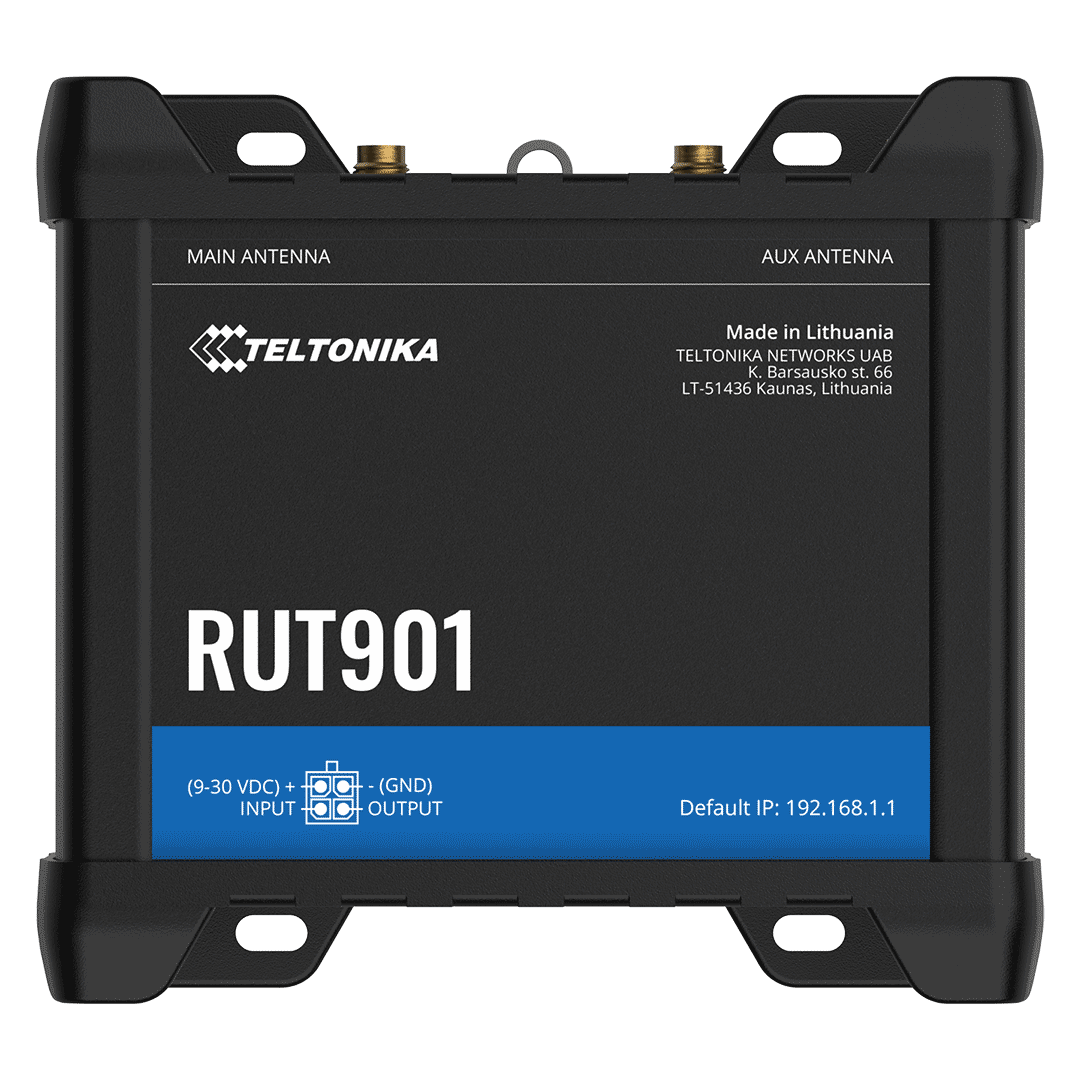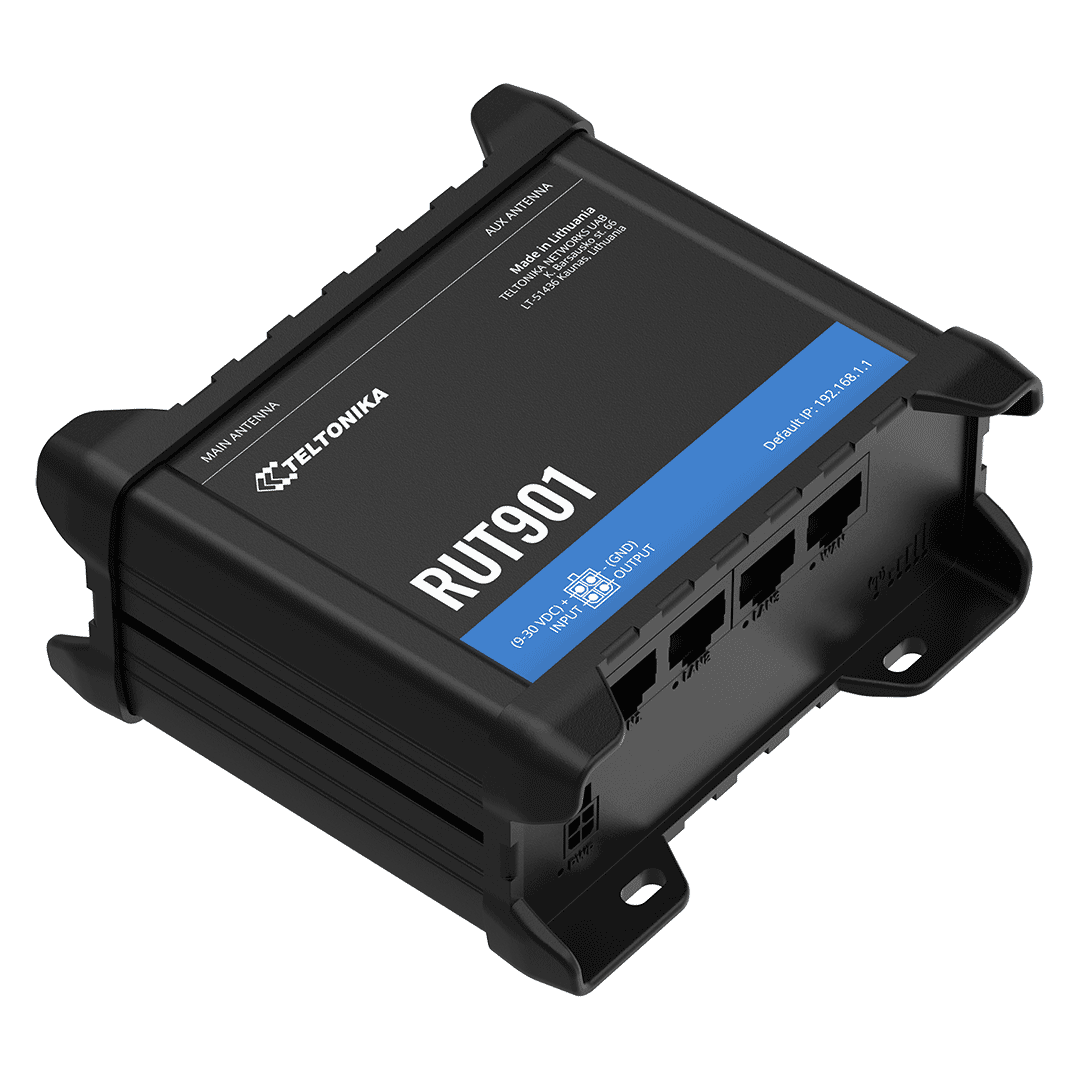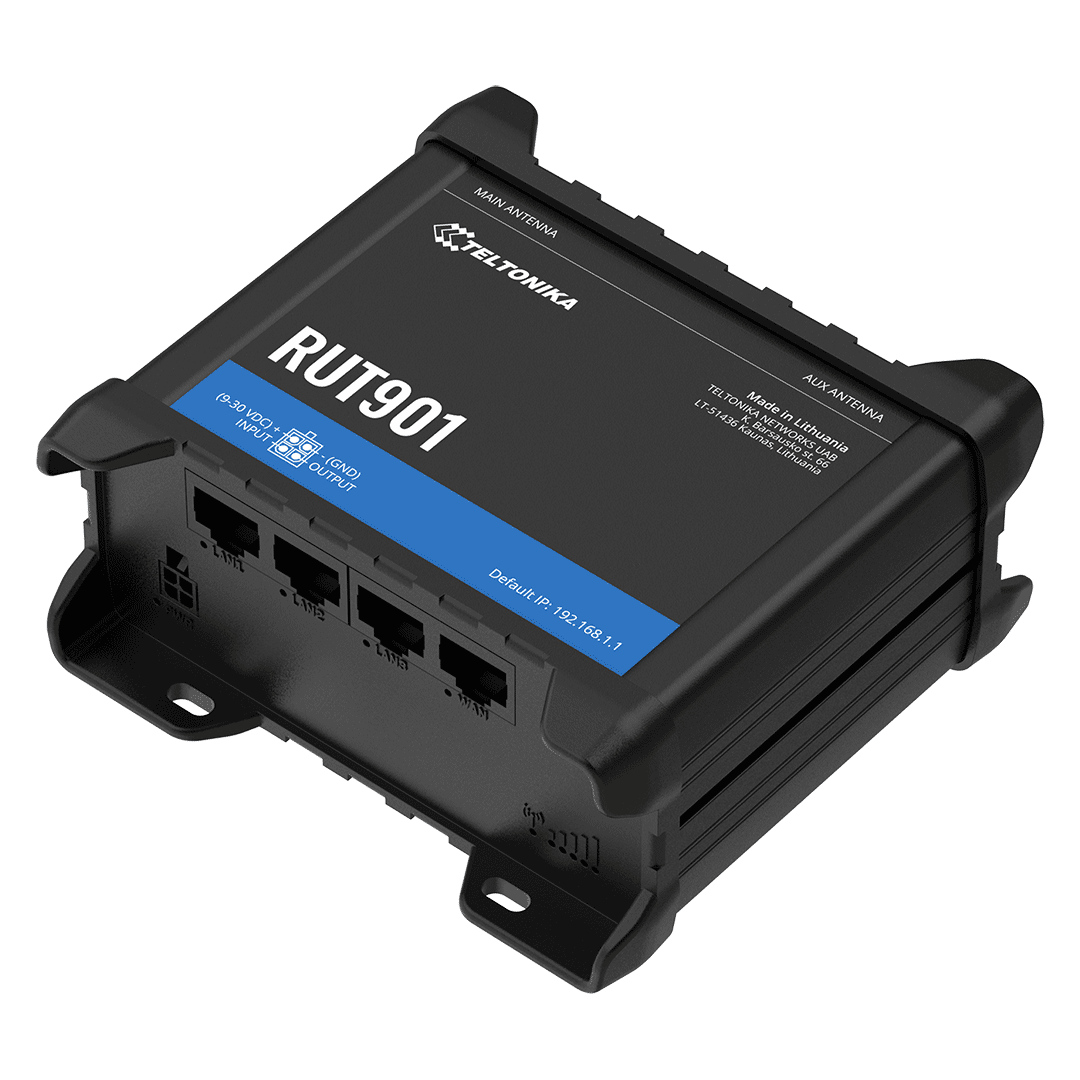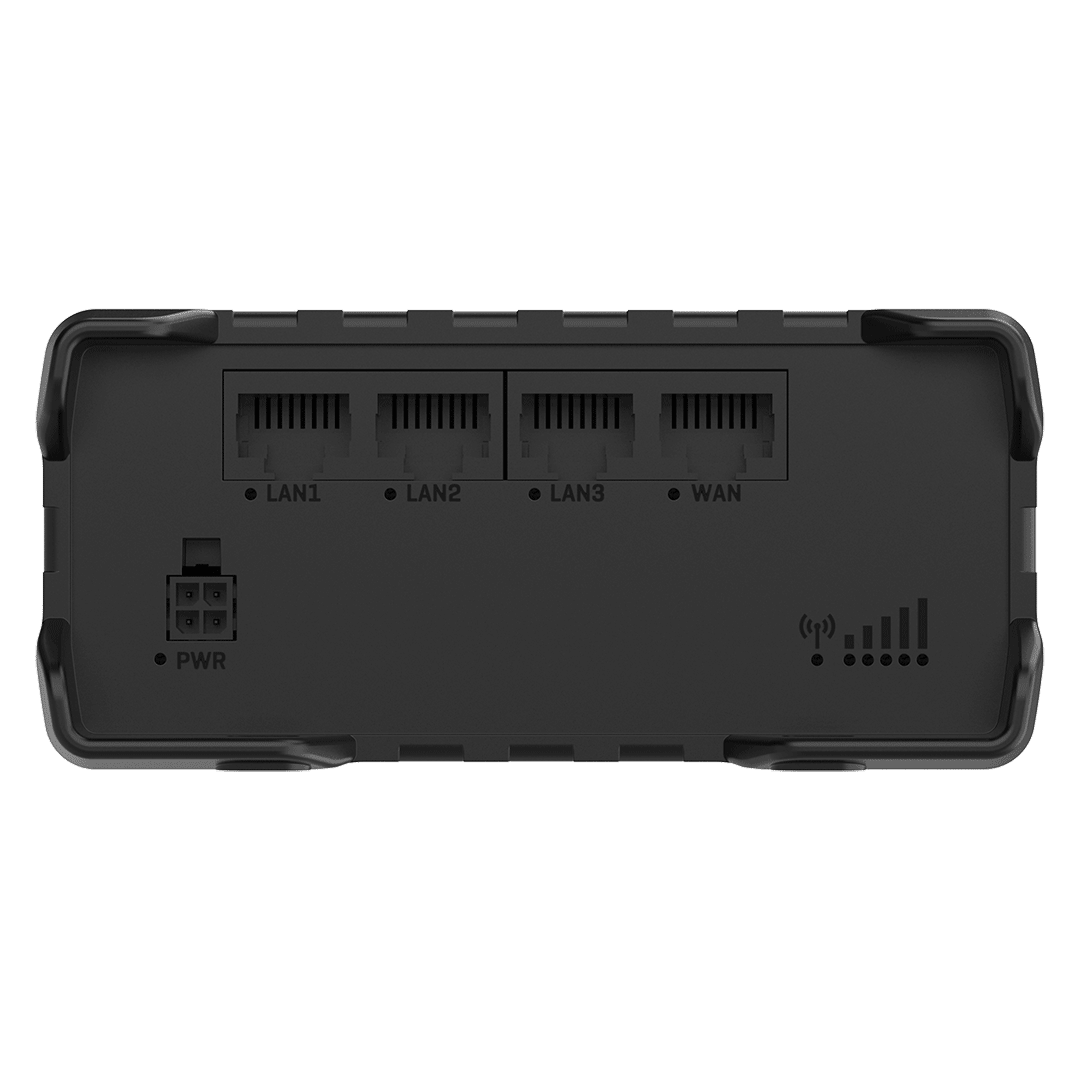




Tekniska specifikationer
Mobile
Cellular module: 4G LTE Cat 4 up to 150 Mbps download / 50 Mbps upload; 3G up to 21 Mbps down / 5.76 Mbps up; 2G up to 236.8 kbps down / 236.8 kbps up
3GPP Release: Release 9
SIM switch: 2 SIM cards, automatic switching when: weak signal, data limit, SMS limit, roaming, no network, network denied, data connection fails, SIM sleep protection
Status: IMSI, ICCID, operator, operator status, data connection status, network type, bandwidth, connected band, signal strength (RSSI), SINR, RSRP, RSRQ, EC/IO, RSCP, sent/received data, LAC, TAC, cell ID, ARFCN, UARFCN, EARFCN, MCC and MNC
SMS: SMS status, SMS configuration, E-MAIL to SMS, SMS to E-MAIL, SMS to HTTP, SMS to SMS, scheduled SMS, SMS auto-reply, SMPP
USSD: Support for sending and reading USSD (Unstructured Supplementary Service Data) messages
Block/Allow List: List to block/allow operators (by country or individual operators)
Multiple PDNs: Ability to use different PDNs for multiple network accesses and services
Tape management: Tape locking, display of currently used tape
SIM sleep protection: Allows you to configure the router to periodically switch to the inactive SIM card and establish a data connection to avoid blocking the SIM card
SIM PIN Management: Allows you to set, change, or disable the SIM card PIN
APN: Automatic APN setting
Bridge: Direct connection (bridge) between mobile operator and device in LAN
Passthrough: The router assigns its mobile WAN IP address to another device on the LAN
3GPP Release: Release 9
SIM switch: 2 SIM cards, automatic switching when: weak signal, data limit, SMS limit, roaming, no network, network denied, data connection fails, SIM sleep protection
Status: IMSI, ICCID, operator, operator status, data connection status, network type, bandwidth, connected band, signal strength (RSSI), SINR, RSRP, RSRQ, EC/IO, RSCP, sent/received data, LAC, TAC, cell ID, ARFCN, UARFCN, EARFCN, MCC and MNC
SMS: SMS status, SMS configuration, E-MAIL to SMS, SMS to E-MAIL, SMS to HTTP, SMS to SMS, scheduled SMS, SMS auto-reply, SMPP
USSD: Support for sending and reading USSD (Unstructured Supplementary Service Data) messages
Block/Allow List: List to block/allow operators (by country or individual operators)
Multiple PDNs: Ability to use different PDNs for multiple network accesses and services
Tape management: Tape locking, display of currently used tape
SIM sleep protection: Allows you to configure the router to periodically switch to the inactive SIM card and establish a data connection to avoid blocking the SIM card
SIM PIN Management: Allows you to set, change, or disable the SIM card PIN
APN: Automatic APN setting
Bridge: Direct connection (bridge) between mobile operator and device in LAN
Passthrough: The router assigns its mobile WAN IP address to another device on the LAN
Wireless
Wireless mode: 802.11b/g/n (Wi-Fi 4), Access Point (AP), Station (STA)
Wi-Fi Security: WPA2-Enterprise: PEAP, WPA2-PSK, WPA-EAP, WPA-PSK, WPA3-SAE, WPA3-EAP, OWE; AES-CCMP, TKIP, automatic encryption modes, client splitting, EAP-TLS with PKCS#12 certificate, disable auto-reconnect, 802.11w Protected Management Frames (PMF)
SSID/ESSID: SSID stealth mode and access control based on MAC address
Wi-Fi users: Up to 100 simultaneous connections
Wireless connectivity features: Fast roaming (802.11r), Relayd, BSS transition management (802.11v), radio resource metering (802.11k)
Wireless MAC filter: Allow list, block list
QR code generator for Wi-Fi: When scanned, the user automatically gains access to the network without having to enter login credentials
TravelMate: Forwards the Wi-Fi hotspot login page to the next connected device
Wi-Fi Security: WPA2-Enterprise: PEAP, WPA2-PSK, WPA-EAP, WPA-PSK, WPA3-SAE, WPA3-EAP, OWE; AES-CCMP, TKIP, automatic encryption modes, client splitting, EAP-TLS with PKCS#12 certificate, disable auto-reconnect, 802.11w Protected Management Frames (PMF)
SSID/ESSID: SSID stealth mode and access control based on MAC address
Wi-Fi users: Up to 100 simultaneous connections
Wireless connectivity features: Fast roaming (802.11r), Relayd, BSS transition management (802.11v), radio resource metering (802.11k)
Wireless MAC filter: Allow list, block list
QR code generator for Wi-Fi: When scanned, the user automatically gains access to the network without having to enter login credentials
TravelMate: Forwards the Wi-Fi hotspot login page to the next connected device
Ethernet
WAN: 1 x WAN port 10/100 Mbps, complies with IEEE 802.3, IEEE 802.3u, 802.3az standards, supports auto MDI/MDIX
LAN: 3 x LAN ports, 10/100 Mbps, complies with IEEE 802.3, IEEE 802.3u standards, supports auto MDI/MDIX
LAN: 3 x LAN ports, 10/100 Mbps, complies with IEEE 802.3, IEEE 802.3u standards, supports auto MDI/MDIX
Network
Routing: Static routing, dynamic routing (BGP, OSPF v2, RIP v1/v2, EIGRP, NHRP), policy-based routing
Network protocols: TCP, UDP, IPv4, IPv6, ICMP, NTP, DNS, HTTP, HTTPS, SFTP, FTP, SMTP, SSL/TLS, ARP, VRRP, PPP, PPPoE, UPNP, SSH, DHCP, Telnet, SMPP, SNMP, MQTT, Wake On LAN (WOL), VXLAN
VoIP passthrough support: H.323 and SIP-ALG protocol NAT helper features that enable proper routing of VoIP packets
Connection Monitoring: Ping Reboot, Wget Reboot, Periodic Reboot, LCP and ICMP for Link Auditing
Firewall: Port forwarding, traffic rules, custom rules, TTL target adjustment
Firewall Status Page: View all firewall statistics, rules, and rule counters
Port Management: View device ports, enable or disable each one, turn auto-configuration on/off, change transfer speed, and more
Network topology: Visual representation of your network showing which devices are connected to each other
Hotspot: Captive portal (hotspot), internal/external Radius server, Radius MAC authentication, SMS authentication, SSO authentication, internal/external landing page, walled garden, user scripts, URL parameters, user groups, restrictions per user or group, user management, 9 predefined customizable themes and the ability to upload and download custom hotspot themes
DHCP: Static and dynamic IP assignment, DHCP relay, DHCP server configuration, status, static leases: MAC with wildcards
QoS / Smart Queue Management (SQM): Prioritization of traffic by source/destination, service, protocol or port, WMM, 802.11e
DDNS: Support for over 25 service providers, others can be configured manually
DNS over HTTPS: DNS over HTTPS proxy enables secure DNS resolution by routing DNS requests over HTTPS
Network backup: Wi-Fi WAN, cellular, VRRP, wired connections – all can be used as automatic failover
Load Balancing: Balance internet traffic across multiple WAN connections
SSHFS: Ability to mount remote file systems via SSH protocol (not available in standard firmware)
Traffic Management: Real-time monitoring, wireless signal graphs, traffic consumption history
Port Mirroring: Mirroring network traffic on Ethernet ports for monitoring and analysis
Network protocols: TCP, UDP, IPv4, IPv6, ICMP, NTP, DNS, HTTP, HTTPS, SFTP, FTP, SMTP, SSL/TLS, ARP, VRRP, PPP, PPPoE, UPNP, SSH, DHCP, Telnet, SMPP, SNMP, MQTT, Wake On LAN (WOL), VXLAN
VoIP passthrough support: H.323 and SIP-ALG protocol NAT helper features that enable proper routing of VoIP packets
Connection Monitoring: Ping Reboot, Wget Reboot, Periodic Reboot, LCP and ICMP for Link Auditing
Firewall: Port forwarding, traffic rules, custom rules, TTL target adjustment
Firewall Status Page: View all firewall statistics, rules, and rule counters
Port Management: View device ports, enable or disable each one, turn auto-configuration on/off, change transfer speed, and more
Network topology: Visual representation of your network showing which devices are connected to each other
Hotspot: Captive portal (hotspot), internal/external Radius server, Radius MAC authentication, SMS authentication, SSO authentication, internal/external landing page, walled garden, user scripts, URL parameters, user groups, restrictions per user or group, user management, 9 predefined customizable themes and the ability to upload and download custom hotspot themes
DHCP: Static and dynamic IP assignment, DHCP relay, DHCP server configuration, status, static leases: MAC with wildcards
QoS / Smart Queue Management (SQM): Prioritization of traffic by source/destination, service, protocol or port, WMM, 802.11e
DDNS: Support for over 25 service providers, others can be configured manually
DNS over HTTPS: DNS over HTTPS proxy enables secure DNS resolution by routing DNS requests over HTTPS
Network backup: Wi-Fi WAN, cellular, VRRP, wired connections – all can be used as automatic failover
Load Balancing: Balance internet traffic across multiple WAN connections
SSHFS: Ability to mount remote file systems via SSH protocol (not available in standard firmware)
Traffic Management: Real-time monitoring, wireless signal graphs, traffic consumption history
Port Mirroring: Mirroring network traffic on Ethernet ports for monitoring and analysis
Security
Authentication: Distributed key, digital certificates, X.509 certificates, TACACS+, internal and external RADIUS user authentication, IP and login attempt blocking, time-based login blocking, built-in random password generator
Firewall: Pre-configured firewall rules can be enabled via WebUI, unlimited firewall configuration via CLI, DMZ, NAT, NAT-T, NAT64
Attack security: DDoS protection (SYN flood protection, protection against SSH and HTTP/HTTPS attacks), port scanning protection (SYN-FIN, SYN-RST, X-mas, NULL flags, FIN scans)
VLAN: Separation of ports and tags via VLAN
Mobile data quota control: Mobile network data limit, customizable period, start time, warning limit, phone number
Web filter: Blacklist to block unwanted websites, whitelist to allow only specified websites
Access Control: Flexible access control for SSH, web interface, CLI and Telnet
SSL Certificate Generation: Support for Let's Encrypt and SCEP as certificate generation methods
Firewall: Pre-configured firewall rules can be enabled via WebUI, unlimited firewall configuration via CLI, DMZ, NAT, NAT-T, NAT64
Attack security: DDoS protection (SYN flood protection, protection against SSH and HTTP/HTTPS attacks), port scanning protection (SYN-FIN, SYN-RST, X-mas, NULL flags, FIN scans)
VLAN: Separation of ports and tags via VLAN
Mobile data quota control: Mobile network data limit, customizable period, start time, warning limit, phone number
Web filter: Blacklist to block unwanted websites, whitelist to allow only specified websites
Access Control: Flexible access control for SSH, web interface, CLI and Telnet
SSL Certificate Generation: Support for Let's Encrypt and SCEP as certificate generation methods
VPN
OpenVPN: Multiple clients and one server can run simultaneously, 27 encryption methods
OpenVPN encryption: DES-CBC 64, RC2-CBC 128, DES-EDE-CBC 128, DES-EDE3-CBC 192, DESX-CBC 192, BF-CBC 128, RC2-40-CBC 40, CAST5-CBC 128, RC2-64-CBC 64, AES-128-CBC 128, AES-128-CFB 128, AES-128-CFB1 128, AES-128-CFB8 128, AES-128-OFB 128, AES-128-GCM 128, AES-192-CFB 192, AES-192-CFB1 192, AES-192-CFB8 192, AES-192-OFB 192, AES-192-CBC 192, AES-192-GCM 192, AES-256-GCM 256, AES-256-CFB 256, AES-256-CFB1 256, AES-256-CFB8 256, AES-256-OFB 256, AES-256-CBC 256
IPsec: XFRM, IKEv1, IKEv2, with 14 IPsec encryption methods (3DES, DES, AES128, AES192, AES256, AES128GCM8, AES192GCM8, AES256GCM8, AES128GCM12, AES192GCM12, AES256GCM12, AES128GCM16, AES192GCM16, AES256GCM16)
GRE: GRE tunnel, support for GRE tunnel over IPsec
PPTP, L2TP: Client and server instances can run simultaneously, support for L2TPv3 and L2TP over IPsec
Stunnel: Proxy designed to add TLS encryption to existing clients and servers without changing the application's code
DMVPN: Method for building scalable IPsec VPN networks, supporting Phase 2, Phase 3 and Dual Hub
SSTP: SSTP client instance support
ZeroTier: ZeroTier VPN client support
WireGuard: Support for both WireGuard VPN client and server
Tinc: Tinc offers encryption, authentication, and compression in its tunnels. Support for both client and server
OpenVPN encryption: DES-CBC 64, RC2-CBC 128, DES-EDE-CBC 128, DES-EDE3-CBC 192, DESX-CBC 192, BF-CBC 128, RC2-40-CBC 40, CAST5-CBC 128, RC2-64-CBC 64, AES-128-CBC 128, AES-128-CFB 128, AES-128-CFB1 128, AES-128-CFB8 128, AES-128-OFB 128, AES-128-GCM 128, AES-192-CFB 192, AES-192-CFB1 192, AES-192-CFB8 192, AES-192-OFB 192, AES-192-CBC 192, AES-192-GCM 192, AES-256-GCM 256, AES-256-CFB 256, AES-256-CFB1 256, AES-256-CFB8 256, AES-256-OFB 256, AES-256-CBC 256
IPsec: XFRM, IKEv1, IKEv2, with 14 IPsec encryption methods (3DES, DES, AES128, AES192, AES256, AES128GCM8, AES192GCM8, AES256GCM8, AES128GCM12, AES192GCM12, AES256GCM12, AES128GCM16, AES192GCM16, AES256GCM16)
GRE: GRE tunnel, support for GRE tunnel over IPsec
PPTP, L2TP: Client and server instances can run simultaneously, support for L2TPv3 and L2TP over IPsec
Stunnel: Proxy designed to add TLS encryption to existing clients and servers without changing the application's code
DMVPN: Method for building scalable IPsec VPN networks, supporting Phase 2, Phase 3 and Dual Hub
SSTP: SSTP client instance support
ZeroTier: ZeroTier VPN client support
WireGuard: Support for both WireGuard VPN client and server
Tinc: Tinc offers encryption, authentication, and compression in its tunnels. Support for both client and server
Modbus
Supported modes: Server, Client
Supported connection types: TCP
Custom registers: MODBUS TCP custom register block requests that read/write to a file in the router, and can be used to extend the functionality of the MODBUS TCP client
Supported data formats: 8-bit: INT, UINT, 16-bit: INT, UINT (MSB or LSB first), 32-bit: float, INT, UINT (ABCD (big-endian), DCBA (little-endian), CDAB, BADC), HEX, ASCII
Supported connection types: TCP
Custom registers: MODBUS TCP custom register block requests that read/write to a file in the router, and can be used to extend the functionality of the MODBUS TCP client
Supported data formats: 8-bit: INT, UINT, 16-bit: INT, UINT (MSB or LSB first), 32-bit: float, INT, UINT (ABCD (big-endian), DCBA (little-endian), CDAB, BADC), HEX, ASCII
Data to server
Protocol: HTTP(S), MQTT, Azure MQTT
Data to Server: Extract parameters from multiple sources and different protocols and send them to a single server. Custom LUA scripting allows scripts to use the router's functionality to send data to the server.
Data to Server: Extract parameters from multiple sources and different protocols and send them to a single server. Custom LUA scripting allows scripts to use the router's functionality to send data to the server.
MQTT Gateway
Modbus MQTT Gateway: Enables sending commands and receiving data from MODBUS server via MQTT broker.
DNP3
Supported modes: Station, Outstation
Supported connection: TCP
Supported connection: TCP
DLMS/COSEM
DLMS support: DLMS – standard protocol for exchanging data from meters
Supported modes: Client
Supported connection types: TCP
COSEM: Enables scanning of the meter's COSEM object for automatic detection and configuration
Supported modes: Client
Supported connection types: TCP
COSEM: Enables scanning of the meter's COSEM object for automatic detection and configuration
API
Teltonika Networks Web API (beta) support: Extend your device's capabilities by using a number of configurable API endpoints to retrieve or modify data. For more information, please see this documentation: https://developers.teltonika-networks.com
Monitoring
Web interface (WEB UI): HTTP/HTTPS, status, configuration, firmware update, CLI, troubleshooting, multiple event log servers, notifications of available firmware updates, event log, system log, kernel log, internet status
FOTA: Firmware update from server, automatic notification
SSH: SSH (v1, v2)
SMS: SMS status, SMS configuration
Calls: Restart, status, mobile data on/off, output on/off, answer/hang up with timer, Wi-Fi on/off
TR-069: OpenACS, EasyCwmp, ACSLite, tGem, LibreACS, GenieACS, FreeACS, LibCWMP, Friendly tech, AVSystem
MQTT: MQTT broker, MQTT publisher
SNMP: SNMP (v1, v2, v3), SNMP Trap, brute force protection
JSON-RPC: Management API over HTTP/HTTPS
RMS: Teltonika Remote Management System (RMS)
FOTA: Firmware update from server, automatic notification
SSH: SSH (v1, v2)
SMS: SMS status, SMS configuration
Calls: Restart, status, mobile data on/off, output on/off, answer/hang up with timer, Wi-Fi on/off
TR-069: OpenACS, EasyCwmp, ACSLite, tGem, LibreACS, GenieACS, FreeACS, LibCWMP, Friendly tech, AVSystem
MQTT: MQTT broker, MQTT publisher
SNMP: SNMP (v1, v2, v3), SNMP Trap, brute force protection
JSON-RPC: Management API over HTTP/HTTPS
RMS: Teltonika Remote Management System (RMS)
IoT platforms
ThingWorx: Enables monitoring of: WAN type, WAN IP, mobile operator name, mobile network signal strength, mobile network type.
Cumulocity – Cloud of Things: Enables monitoring of: Device model, revision and serial number, WAN type and IP, mobile cell ID, ICCID, IMEI, connection type, operator, signal strength. Supports reboot and firmware upgrade.
Azure IoT Hub: Can be configured with "Data to Server" to send all available parameters to the cloud. Supports Direct Method, allowing to run RutOS API calls from IoT Hub. Also supports Plug and Play integration with Device Provisioning Service, enabling automated provisioning to IoT Hubs.
AWS IoT Core: Tools for interacting with the AWS cloud platform. Jobs Support: Ability to call the device API via AWS Jobs functionality.
Cumulocity – Cloud of Things: Enables monitoring of: Device model, revision and serial number, WAN type and IP, mobile cell ID, ICCID, IMEI, connection type, operator, signal strength. Supports reboot and firmware upgrade.
Azure IoT Hub: Can be configured with "Data to Server" to send all available parameters to the cloud. Supports Direct Method, allowing to run RutOS API calls from IoT Hub. Also supports Plug and Play integration with Device Provisioning Service, enabling automated provisioning to IoT Hubs.
AWS IoT Core: Tools for interacting with the AWS cloud platform. Jobs Support: Ability to call the device API via AWS Jobs functionality.
System features:
Processor (CPU): Mediatek, 580 MHz, MIPS 24KEc
RAM: 128MB DDR2
Flash Storage: 16 MB SPI Flash
RAM: 128MB DDR2
Flash Storage: 16 MB SPI Flash
Firmware configuration
Web interface (WEB UI): Update firmware from file, check firmware on server, manage configuration profiles, backup configuration
FOTA (Firmware Over The Air): Remote firmware update
RMS (Remote Management System): Update firmware and/or configuration for multiple devices simultaneously
Keep settings: Update firmware without losing existing configuration
Factory Reset: A full factory reset restores all system settings, including IP address, PIN, and user data, to the manufacturer's default configuration.
FOTA (Firmware Over The Air): Remote firmware update
RMS (Remote Management System): Update firmware and/or configuration for multiple devices simultaneously
Keep settings: Update firmware without losing existing configuration
Factory Reset: A full factory reset restores all system settings, including IP address, PIN, and user data, to the manufacturer's default configuration.
Firmware customization
Operating system: RutOS (Linux-based operating system based on OpenWrt)
Supported programming languages: Busybox shell, Lua, C, C++
Development tools: SDK package with accompanying build environment provided
GPL Customization: Create your own customized and branded firmware and web interface by changing colors, logos, and other elements of our firmware – tailored to your or your customers’ needs
Package Manager: A service for installing additional software on the device
Supported programming languages: Busybox shell, Lua, C, C++
Development tools: SDK package with accompanying build environment provided
GPL Customization: Create your own customized and branded firmware and web interface by changing colors, logos, and other elements of our firmware – tailored to your or your customers’ needs
Package Manager: A service for installing additional software on the device
Inputs / Outputs
Input (Digital Input): 1 x digital input 0–6 V is detected as a low signal (logical zero) 8–30 V is detected as a high signal (logical one)
Output (Digital Output): 1 x digital output, Open collector output, Max output voltage: 30 V, Max current: 300 mA
Events: Ability to trigger events via Email, RMS (Remote Management System), SMS
I/O Juggler: Allows you to define certain I/O conditions to initiate events automatically
Output (Digital Output): 1 x digital output, Open collector output, Max output voltage: 30 V, Max current: 300 mA
Events: Ability to trigger events via Email, RMS (Remote Management System), SMS
I/O Juggler: Allows you to define certain I/O conditions to initiate events automatically
Current
Power connector: 4-pin industrial DC power connector
Input voltage: 9–30 VDC
Reverse polarity protection
Surge protection: >31 VDC for max 10 μs
PoE (passive): Passive PoE via spare pair (Mode B)
Ability to power the device via the LAN1 port
NOTE: Not compatible with IEEE 802.3af, 802.3at or 802.3bt standards
Voltage range: 9–30 VDC
Power consumption: < 2 W in sleep mode < 7 W max
Input voltage: 9–30 VDC
Reverse polarity protection
Surge protection: >31 VDC for max 10 μs
PoE (passive): Passive PoE via spare pair (Mode B)
Ability to power the device via the LAN1 port
NOTE: Not compatible with IEEE 802.3af, 802.3at or 802.3bt standards
Voltage range: 9–30 VDC
Power consumption: < 2 W in sleep mode < 7 W max
Physical connections
Ethernet: 4 x RJ45 ports, 10/100 Mbps
I/O: 1 x Digital input, 1 x Digital output via 4-pin power connector
Status LED: 1 x Bi-color for connection status 5 x For mobile signal strength 4 x For Ethernet status 1 x For power status
SIM: 2 x SIM card slots (Mini SIM – 2FF), 1.8 V / 3 V
External SIM holders
eSIM (optional – requires different hardware, contact your seller)
Power: 1 x 4-pin power connector
Antennas: 2 x SMA connectors for LTE 2 x RP-SMA connectors for Wi-Fi
Reset: Button for restart, reset to user defaults or factory reset
I/O: 1 x Digital input, 1 x Digital output via 4-pin power connector
Status LED: 1 x Bi-color for connection status 5 x For mobile signal strength 4 x For Ethernet status 1 x For power status
SIM: 2 x SIM card slots (Mini SIM – 2FF), 1.8 V / 3 V
External SIM holders
eSIM (optional – requires different hardware, contact your seller)
Power: 1 x 4-pin power connector
Antennas: 2 x SMA connectors for LTE 2 x RP-SMA connectors for Wi-Fi
Reset: Button for restart, reset to user defaults or factory reset
Physical specifications
Enclosure material: Aluminum housing with plastic panels
Dimensions (W x H x D): 110 x 50 x 100 mm
Weight: 297g
Mounting options: DIN rail, wall mount, flat surface (all options require additional mounting kit)
Dimensions (W x H x D): 110 x 50 x 100 mm
Weight: 297g
Mounting options: DIN rail, wall mount, flat surface (all options require additional mounting kit)
Operating environment
Operating temperature: -40°C to 75°C
Operating humidity: 10% to 90% (non-condensing)
Ingress Protection Rating: IP30
Operating humidity: 10% to 90% (non-condensing)
Ingress Protection Rating: IP30
Regulatory approvals and type approvals
Regulatory approvals and type approvals
CE, UKCA, IMDA, Anatel, RCM, E-mark, ECE R118, CB, RoHS, REACH, NCC
CE, UKCA, IMDA, Anatel, RCM, E-mark, ECE R118, CB, RoHS, REACH, NCC
EMC
Standards: EN 55032:2015 + A11:2020 + A1:2020, EN 55035:2017 + A11:2020, EN IEC 61000-3-2:2019 + A1:2021, EN 61000-3-3:2013 + A1:2019 + A2:2021, EN 301 489-1 V2.2.3, EN 301 489-17 V3.2.4, EN 301 489-52 V1.2.1, ESD (Electrostatic Discharge):, EN 61000-4-2:2009
Radiated Immunity: EN IEC 61000-4-3:2020
Fast transients (EFT): EN 61000-4-4:2012
Voltage spikes (AC mains port): EN 61000-4-5:2014 + A1:2017
Portable interference (CS): EN 61000-4-6:2014
DIP (voltage dips and interruptions): EN 61000-4-11:2020
Radiated Immunity: EN IEC 61000-4-3:2020
Fast transients (EFT): EN 61000-4-4:2012
Voltage spikes (AC mains port): EN 61000-4-5:2014 + A1:2017
Portable interference (CS): EN 61000-4-6:2014
DIP (voltage dips and interruptions): EN 61000-4-11:2020
RF
Standards: EN 300 328 V2.2.2, EN 301 511 V12.5.1, EN 301 908-1 V15.1.1, EN 301 908-2 V13.1.1
EN 301 908-13 V13.1.1
EN 301 908-13 V13.1.1
Performance specifications
Standards: CE: EN IEC 62368-1:2020 + A11:2020, EN IEC 62311:2020, EN 50665:2017
CB: IEC 62368-1:2018
RCM: AS/NZS 62368.1:2022
CB: IEC 62368-1:2018
RCM: AS/NZS 62368.1:2022
Garanti
2 års fabriksgaranti

Mobile connectivity for different environments

Dual SIM card slots

Wireless access point

Industrial communication protocols

Do you want to know more about the product?
Contact us for a demo or if you have any questions.




